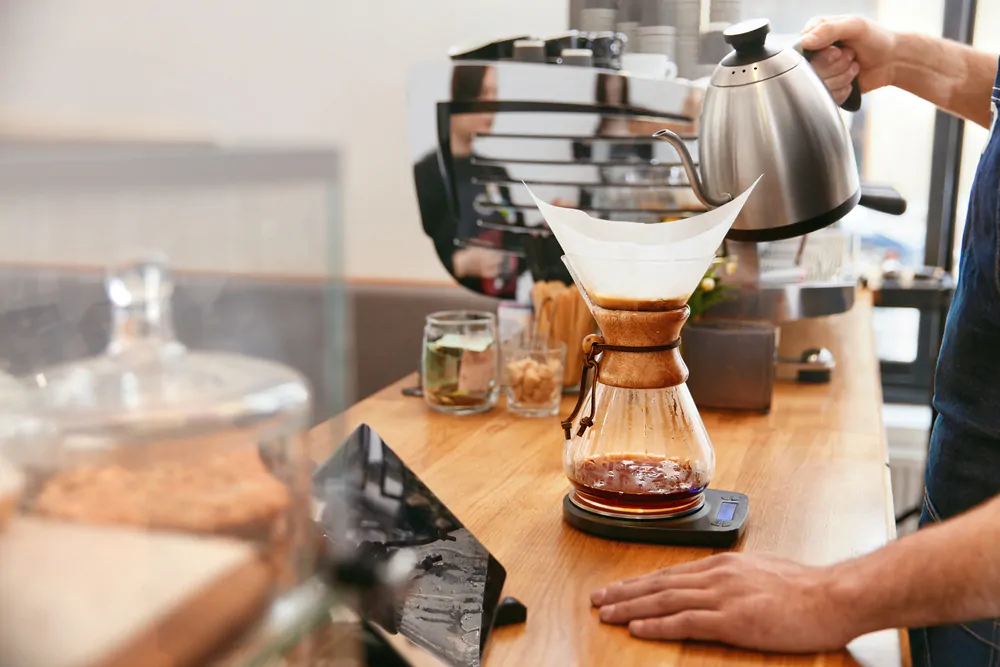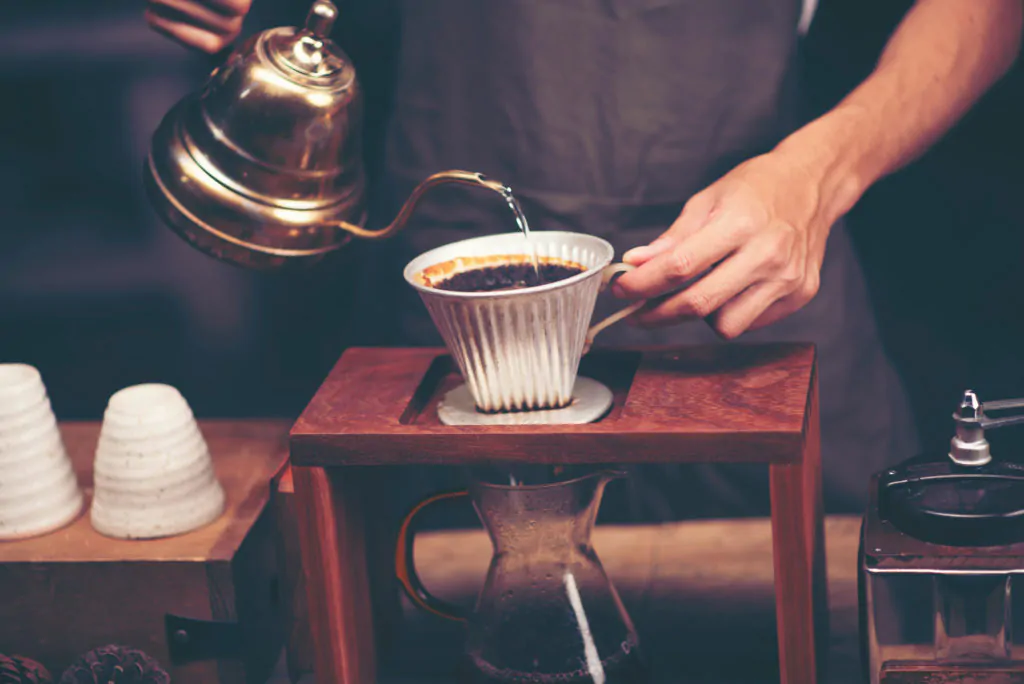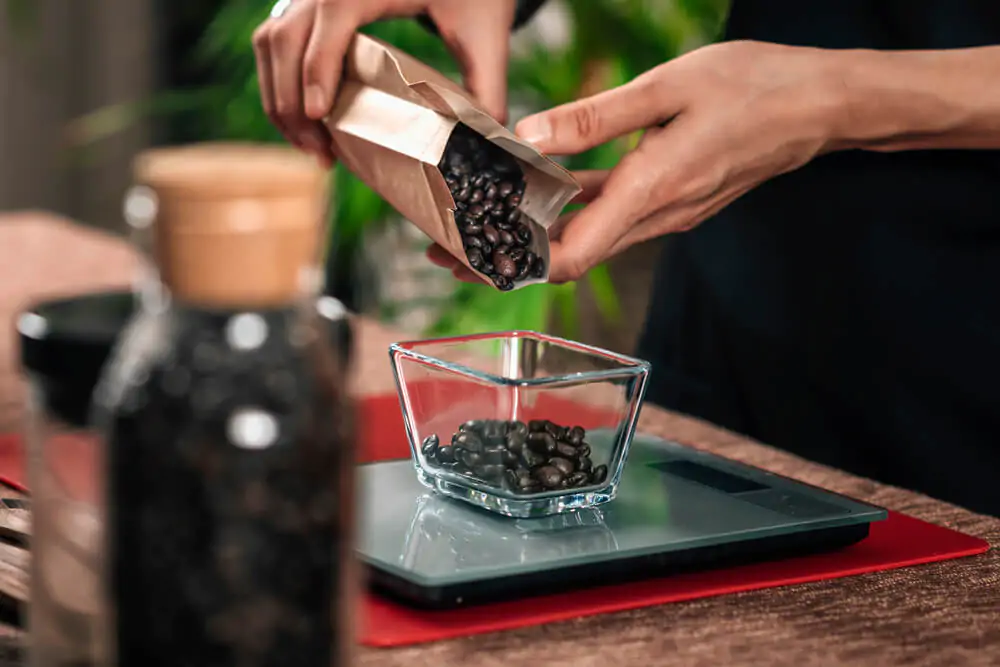If you are ready to start making better coffee, use the pour over coffee to water ratio pour over masters prefer when they make themselves coffee at home.

It seems that these days everyone is on the quest to brew a better cup of coffee. For many, the manual pour over method ticks more boxes than any other way of brewing coffee when it comes to convenience and customization. For the best results, start with a 1:16 coffee to water ratio and experiment from there.
Isn’t Pour Over Coffee the Same as Drip Coffee?

Growing up, most of us only knew two ways of preparing coffee; using a percolator or an automatic drip coffee machine. Today there are almost endless coffee brewing options, and one of the most hyped is the manual pour over method. But isn’t this method just the same as an automatic drip coffee machine without using electricity?
No, although the basic principles of both brewing methods are similar, and the coffee to water ratio remains the same, as the saying goes, the devil is in the details. Automatic drip is a set-it-and-forget-it way to brew average coffee, and while it is easy, it lacks the capability to modify the brewing process to get the best results.
On the other hand, manual pour over brewing gives you ultimate control regarding factors like coffee to water ratio, water temperature, and extraction time. Unfortunately, the freedom to make changes also means that it is a whole heck of a lot easier to make really bad coffee using the pour over method than just about any other brewing method.
Why Talk About Ratios Instead of Recipes?
A good starting coffee to water ratio for making pour over coffee is 1:16. That is one gram of coffee for every 16 milliliters of water. But no one drinks just 16 milliliters of coffee, so why not have a little more helpful recipe?
Sure, you could have a recipe that reads “10.5 grams of coffee per 6 ounces of water,” but what if your favorite coffee cup holds 10 ounces? Or, imagine if you only had 9 grams of coffee grounds left? How much coffee can you make?
It is important to remember that the ratio does not use volume but weight in metric units. If you forgot about metric conversion, one fluid ounce equals about 30 milliliters of water (29.57 milliliters, if you want to be exact) in the US. When weighing, 1 milliliter of water is 1 gram.
Getting a Manual Pour Over System Up and Running

A basic pour over system is simple and relatively inexpensive. However, it’s easy to spend hundreds of dollars on equipment that looks amazing but isn’t necessary for a fabulous cup of coffee. The absolute essentials you need include a dripper, a filter, a container for heating and pouring water, a thermometer, and a scale.
The Dripper
The dripper is one of the most critical parts of your setup. You can choose among many different designs, from large, small, some with ridges, others without, but all will work. Buy one that is well-constructed, sits securely on top of whatever you’re pouring the coffee into, and holds the amount of coffee you need to make.
The Filter
Some drippers come with built-in filters, but most use disposable paper ones. Built-in, reusable filters may save you money day-to-day, but they require extra cleaning time and will eventually need replacing. Paper filters make clean-up as easy as throwing the used filter in the trash.
There are two types of paper filters, the white, bleached ones, and the unbleached brown variety. Some people think that unbleached filters can give the coffee a papery taste, but prewetting the filter can help to eliminate it.
The Heating and Pouring Container
Sure, you can use any heat-proof container for this, but it is worth spending a little bit of money on a goose-neck pitcher that is specifically designed for making pour over coffee. The thin spout of the goose-neck pitcher lets you wet the coffee grounds slowly and precisely.
The Thermometer
Higher temperatures extract coffee faster than lower ones. For pour over coffee, the ideal range is from 195 – 205 degrees. If you find your coffee too bitter, try a lower temperature; use a higher temperature if your coffee turns out too sour.
The Scale

Measuring by volume just won’t cut it if you want to brew the best coffee. You need a decent electric kitchen scale. For less than 20 dollars, it is a good investment in your coffee drinking. You might also be interested in our Moka Pot. vs Pour Over guide.
Final Word: The Best Pour Over Coffee To Water Ratio
Although pour over coffee takes more time and practice than other brewing methods, once you master it, you will have the ultimate control over how your coffee tastes. Learn the basics using the standard 1:16 coffee to water ratio, and after gaining some experience, don’t be afraid to experiment to find what you enjoy.
FAQ About Pour Over Coffee To Water Ratio
What ground size should I use for pour over coffee?
While the perfect ground size may change based on the type of dripper you are using, a medium to a medium-fine grind usually works great. Since the water is not in contact with the coffee grounds for that long, anything coarser than a medium grind will taste weak.
How do I pour the water over the coffee?
Start in the center of the filter and slowly pour in a spiral motion to the outer edge of the coffee. Use about two times as much water as there is coffee and wait for 40 seconds. Baristas call this blooming the coffee, and it ensures all the coffee grounds are wet.
After 40 seconds, continue to pour in the rest of the water in the same spiral motion. When you reach the edge of coffee, keep pouring in the same motion but move towards the center. Continue until the water is gone.
